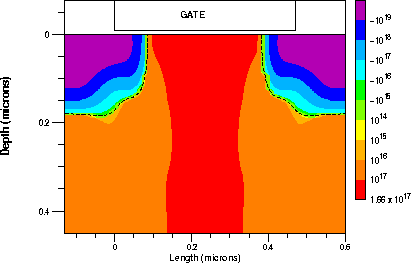5.1.2 Parameters Extraction





Next: 5.1.3 Comparisons with Experimental
Up: 5.1 Mobility Model Calibration
Previous: 5.1.1 Model Equations
The two-dimensional profile of the P-channel MOSFET (Fig.5.1), oxide
thickness ( ), polysilicon gate concentration (
), polysilicon gate concentration ( ), and polysilicon
gate length (
), and polysilicon
gate length ( ) are all experimentally obtained as described in Chapter 4.
These values are used as such in MINIMOS simulations. Five
mobility model parameters (
) are all experimentally obtained as described in Chapter 4.
These values are used as such in MINIMOS simulations. Five
mobility model parameters ( ,
,  ,
,  ,
,  and
and  ) of (5.1) and (5.2) are then extracted.
) of (5.1) and (5.2) are then extracted.

Figure 5.1:
P-Channel extracted profile
To ensure the extraction of physically meaningful parameter values,
a regional optimization approach is followed. The nonlinear optimization is
performed in stages using different measurement conditions with strong
dependence on a subset of the mobility parameters. First the mobility
coefficients given in (5.1) ( ,
,  and
and  ),
and the gate work function (
),
and the gate work function ( ) are extracted
by matching experimental long channel I-V characteristics in the linear
region.
) are extracted
by matching experimental long channel I-V characteristics in the linear
region.  Current data at low
Current data at low  and varying
and varying  and
and
 are used to ensure that the influence of the low field mobility
parameters is dominant. Using the same mobility parameters as determined
for the long channel device, the linear region current of multiple length
short channel devices were fitted by adjusting
are used to ensure that the influence of the low field mobility
parameters is dominant. Using the same mobility parameters as determined
for the long channel device, the linear region current of multiple length
short channel devices were fitted by adjusting  to allow for the effect
of contact resistance and
to allow for the effect
of contact resistance and  to model gate workfunction differences
due to interface charge variation. It is important to note that the same
mobility parameters are used for all device lengths.
to model gate workfunction differences
due to interface charge variation. It is important to note that the same
mobility parameters are used for all device lengths.
Once the linear region parameter values were obtained, the remaining
parameters  and
and  are then extracted using saturation
region I-V data from short channel devices.
are then extracted using saturation
region I-V data from short channel devices.
Martin Stiftinger
Tue Aug 1 19:07:20 MET DST 1995
 ), polysilicon gate concentration (
), polysilicon gate concentration ( ), and polysilicon
gate length (
), and polysilicon
gate length ( ) are all experimentally obtained as described in Chapter 4.
These values are used as such in MINIMOS simulations. Five
mobility model parameters (
) are all experimentally obtained as described in Chapter 4.
These values are used as such in MINIMOS simulations. Five
mobility model parameters ( ,
,  ,
,  ,
,  and
and  ) of (5.1) and (5.2) are then extracted.
) of (5.1) and (5.2) are then extracted.






 ),
and the gate work function (
),
and the gate work function ( ) are extracted
by matching experimental long channel I-V characteristics in the linear
region.
) are extracted
by matching experimental long channel I-V characteristics in the linear
region.  Current data at low
Current data at low  and varying
and varying  and
and
 are used to ensure that the influence of the low field mobility
parameters is dominant. Using the same mobility parameters as determined
for the long channel device, the linear region current of multiple length
short channel devices were fitted by adjusting
are used to ensure that the influence of the low field mobility
parameters is dominant. Using the same mobility parameters as determined
for the long channel device, the linear region current of multiple length
short channel devices were fitted by adjusting  to allow for the effect
of contact resistance and
to allow for the effect
of contact resistance and